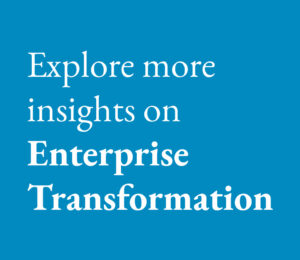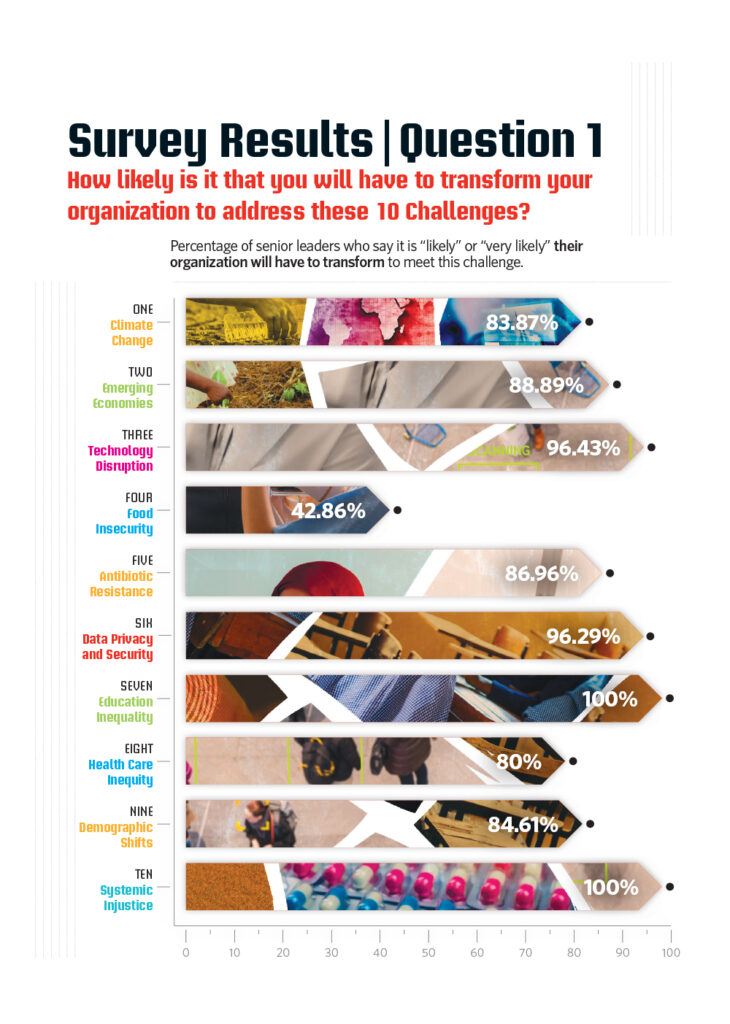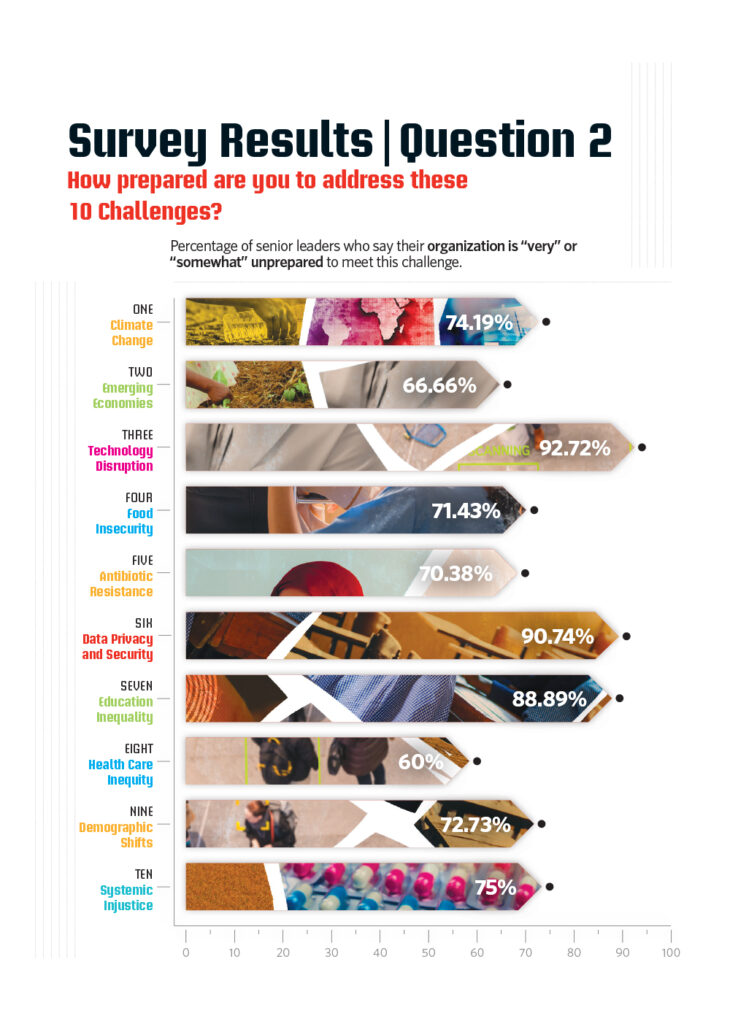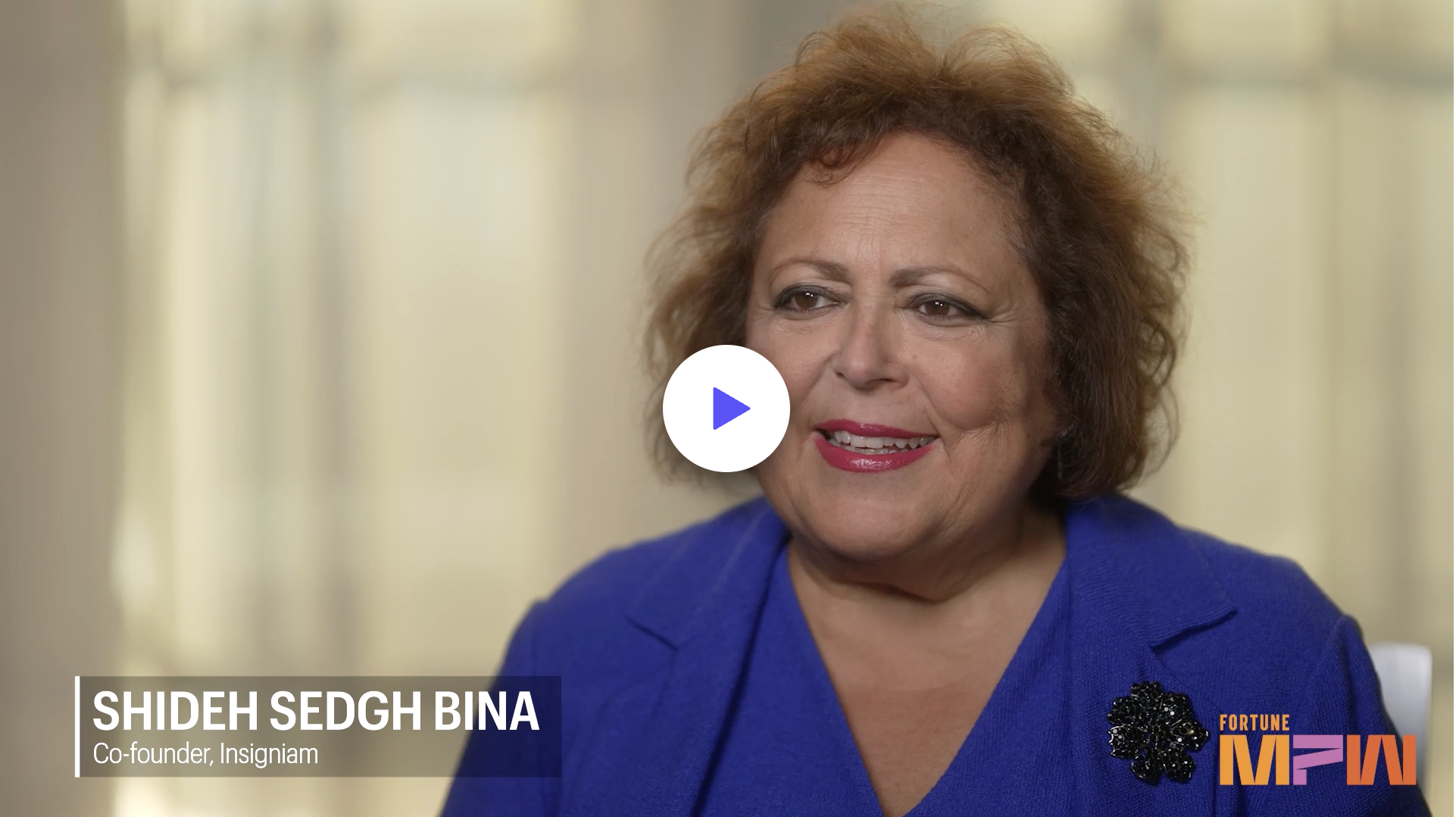- Enterprise Transformation
- Insigniam Perspectives
- IQ Insigniam Quarterly® Magazine
- Take Action: The Future Is Now
The Clash of Organizational Transformation and Linear Thinking
Insigniam recently surveyed senior leaders about 10 of the largest challenges facing business, and the world, today. As one would expect, the survey revealed differing priorities and responses to challenges as diverse as global food security and the increasing pace of technological change. But the responses also highlighted a widespread understanding that business as usual is inadequate to effectively respond to challenges of this magnitude. Instead, leaders realize that in many cases, a wholesale organizational transformation is required to be an effective actor in this new and progressively more complex world.

How, then, can leaders think of transformation on such a scale, and of such impact, that it would be adequate to steer a company through a mega-challenge such as, say, climate change? It should seem obvious that such an organizational transformation can’t be planned in a linear way. Large organizations are complex adaptive systems that constantly evolve through the actions of independent agents—from employees and customers to shareholders, regulators and other stakeholders. That’s the case even before we contemplate the massive changes that are being wrought by the forces detailed in this issue.
Yet many organizations continue to rely on linear thinking to address changes that are complex and unpredictable. These organizations act as if a sufficiently detailed, perfectly enforced command-and-control paradigm will enable them to properly respond to changes that are surprising and outpacing them on every front. The task of organizational transformation in a complex world can be likened to that of herding cats. An extremely linear thinker, faced with 20 cats on the left side of a room and wanting to move them to the right, might pick up one cat, move it to the right, and repeat. Of course, that cat is unlikely to stay on the right side of the room, and our linear thinker is unlikely to outlast 20 cats.
But it is possible to set conditions that will cause most, if not all, of the cats to end up on the right. Placing cat food on the right side of the room might help. You could also make sure the left side of the room smells like something cats don’t like, such as citrus or rosemary. Better yet, figure out some clever way to tilt the floor.
Similarly, leaders can set the conditions that will cause their organizations to transform, and to support the emergence of a future state that is more appropriate to today’s levels of complexity and change. Share on X Through our work with large companies in all industries and geographies, we’ve found five conditions that set the stage for transformational change.
A Organizational Transformation Must Be Anchored in a Clear Purpose That Is Worthy of People’s Personal Commitment
Defining a clear purpose for an organizational transformation calls upon one of the most basic tasks of leadership: to show people the way forward, and to show why the new world they are being asked to build is superior to the old. The transformation has to express the possibility of a new order, and must be anchored in what would be considered breakthrough results. Without this clear purpose, the effort required to successfully transform the organization will not seem worthy of commitment on the part of those required to put it into action.
 This breakthrough outcome could relate to an organization’s products or its processes. As a breakthrough outcome, an organization might seek to successfully implement a new technology, whether that’s new to the organization or something that has yet to be invented. A breakthrough outcome could also be a dramatic reduction in carbon footprint, or a dramatic improvement in the health and wellness of employees.
This breakthrough outcome could relate to an organization’s products or its processes. As a breakthrough outcome, an organization might seek to successfully implement a new technology, whether that’s new to the organization or something that has yet to be invented. A breakthrough outcome could also be a dramatic reduction in carbon footprint, or a dramatic improvement in the health and wellness of employees.
Culture and Business Must be Integrated
Because organizational transformations can seem so overwhelming, it’s tempting, and sometimes helpful, to put tasks and goals into buckets. But business and culture often get put into separate buckets—the hard and the soft—which is a mistake. Culture is simply how people think and act. It is part of every aspect of the organization. Your finance team, arguably working on the “hard” side of the business, has its own culture, while also contributing to and being affected by the culture of the larger organization. It’s impossible to work on the business without also affecting the culture.
Ask what characteristics a culture would need to have in order to support the transformation you seek.
When taking on an organizational transformation, it’s important to ask if your organization has a culture that will support the outcomes of such a transformation. This needs to be more than a gut check: Ask what characteristics a culture would need to have in order to support the transformation you seek. Once those specific qualities are identified, it’s time to identify them in your culture, and create or strengthen them if necessary.
Engage with People Who See the World Differently

Percentage of companies surveyed that say they are “very unprepared” to deal with the challenges presented by emerging economies.
It’s easy for us to get caught in our own little bubbles. But we’re unlikely to solve any of the large challenges ahead of us without new perspectives—if our existing knowledge and approaches were enough, we probably would have solved many of these problems already. That means we need to actively seek out perspectives that differ from our own, and we need to build an organization that encourages its staff to do the same.
There are both formal and informal ways to do this. Essentially, this is about asking new questions. It’s not too much to bring an anthropologist into your organization to help you see things in a new way. When we work on innovation, we bring together panels of thought leaders that bring together people with different perspectives. That gives clients and their partners an opportunity to hear from, and engage with, people who have different ways of thinking, different areas of domain expertise and different backgrounds.
But these sorts of initiatives will have limited impact if your organization doesn’t value this type of engagement. In that case, it will take an intentional effort to become more open and more engaged with other points of view. Look at your organization and how work is typically structured. When could new connections take place? Is time for that activity valued and protected? How much does your organization encourage people to develop themselves, outside of the expected professional development pathways? On a more personal level, how much do you read, and does your chosen reading material show a curiosity about the world outside your industry?
 Reinvent Stakeholder Relationships and Partnerships as a Coalition
Reinvent Stakeholder Relationships and Partnerships as a Coalition
The time during which businesses could succeed simply by managing transactions with employees, vendors and customers is long past—if indeed it ever existed at all. For an organizational transformation, businesses need to reinvent the ways they work with their stakeholders. We express this as reinventing stakeholder relationships to form a coalition, which we define as a group of people with different concerns coming together for a common commitment.
The potential future for the aviation industry provides one example. It’s unlikely that large aviation companies will dramatically reduce their carbon footprint if they choose to work in the industry’s traditional ways. The existing supply chain is locked into place, and it benefits from a complex web of relationships that resist change. For aviation to become significantly more green, a multitude of players will need to invent new fuels, materials and possibly business models. These will likely come from startups and others who aren’t part of the existing aviation supply chains. That means the larger companies will need to reconsider their supplier relationships and the rules of engagement that govern their work with smaller vendors. A complex coalition of stakeholders will guide, monitor and support progress toward organizational transformation.
Meanwhile, other players in the aviation industry will be undergoing their own transformations, underlining the futility of trying to plan a transformation using only linear thinking.
Do No Harm, Correct If You Do, and Better Yet, Strive to Do Good While Creating Prosperity for Others
Over the past several years, stakeholder capitalism has created an environment in which a company can’t be only about profits. Instead, for-profit entities are expected to be a force for some good in the world, even above the obvious benefits of providing jobs, goods and services that people want and need. In a highly interconnected world, organizational transformation will need to take into account the impact on all stakeholders, both internal and external. No organization can afford to operate with blinders on when it comes to its total impact on its ecosystem. It’s imperative to ask yourself, at the very least, if your actions are a match for your purposes and your stakeholder commitments.
The pandemic has caused both senior leadership and individual contributors to reassess the level of interconnectedness in the world, according to research from Insigniam.
This alignment—or lack thereof—is one way to assess an organization’s authenticity. And authenticity matters more than leaders might at first think. It is an attribute stereotypically valued by millennials, but few customers, shareholders or employees would choose to interact with an organization that says one thing while it does another. The pandemic has caused both senior leadership and individual contributors to reassess the level of interconnectedness in the world, according to research from Insigniam. Believing that any untoward behavior can be compartmentalized away is a mindset of the past.
 No Two Organizations—or Transformations—Are Alike
No Two Organizations—or Transformations—Are Alike

Percentage of companies surveyed that say they will “very likely” need to transform to meet the challenges posed by technology disruption.
In our work with clients across industries and geographies, we’ve seen that the five conditions above are necessary enablers of organizational transformation. But this list is not exhaustive. There will be a small number of additional conditions that are unique to your organization and its transformation.
Organizations have developed their own tools for transformation for years, and it’s imperative that they continue to do so. Six Sigma and Lean were originally invented to meet the needs of a single company (Motorola and Toyota, respectively, with the latter drawing inspiration from Henry Ford). What is the tool or condition that is perfectly suited to respond to the unique needs of your company? The right conditions will allow the emergence of the necessary transformations, while inappropriate ones will cause unnecessary confusion and delay. It’s up to leaders to understand the difference, and to build or adopt the frameworks that will best enable their own organizational transformation.
This article appeared in the Winter 2022 issue of Insigniam Quarterly. To begin receiving IQ, go here.




